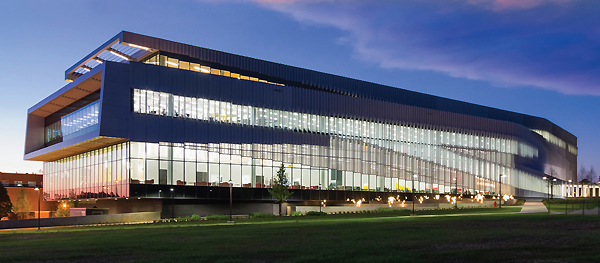James B. Hunt Jr. Library | New Landmark Libraries 2016 Winner
Innovation Incubator
North Carolina State University | Raleigh ARCHITECT Snøhetta
When the James B. Hunt Jr. Library at North Carolina State University (NCSU) in Raleigh opened in 2013, it aimed to define the research library of the 21st century. Designed by Snøhetta, the Hunt illustrates how a library can serve as a key component of academic life. In its place on the Centennial campus, sitting at the edge of a grand oval green space, the library connects two sections of campus, improves walkability, and anchors student activity across the represented disciplines.
V I T A L S OPENED January 2013 TOTAL SQUARE FEET 221,122 COST $93.75 million LEED Silver
This Leadership in Energy & Environmental Design (LEED) Silver-certified building’s HVAC system monitors CO2 in the building and pulls in fresh air on a regular basis, ensuring interior air is never stale. Custom colored carpet patterns mirror plants in the rain garden, visible from outside and in. This subtly reinforces the integration of aesthetic and sustainable design. Glass is used generously throughout. Interior glass is used in both student and staff-facing areas: the result is a light-filled, energetic environment that inspires and engages. The design team chose FibreC, a glass fiber–reinforced concrete material, for much of the exterior and to clad the circulation core of the building. This high quality material is durable and environmentally sustainable.

BRIGHT FUTURE (Top): The Hunt Library at night. Photo ©Jeff Goldberg/Esto.
(l.-r.): colorful spaces serve as inspiration; the main floor tech showcase; and the Skyline Terrace.
Terrace photo ©Jeff Goldberg/Esto; all other photos by Kevin Henegan
Right place, right time
The library offers flexible spaces to serve the population of 33,989 students, as well as faculty, at every stage in their academic work, from initial information searches and data gathering to formal presentations. A wealth of seating options enable users to make choices about where and how they use the building and its resources. Both academic and community events can be housed in a flexible 400-seat auditorium, 100-seat lecture hall, or subdividable multipurpose rooms. Floors and ceilings offer raised access buildingwide, so network and power can be changed easily based on demand or services in each area.
Even staff-facing spaces are designed to foster engagement and transparency. Staff are consolidated, which yields more areas for students and faculty and encourages fluid collaboration among departments. The same principles of enabling a variety of functions in the public space are replicated in staff space: ubiquitous access to natural light, breakout rooms equipped with technology, and more private desk areas that allow for focused work.
NCSU serves a unique role in its community as a technology incubator for the region. The Hunt Library approaches this role with specialized spaces designed specifically for 3-D computing, advanced visualization, and gaming research and development. The nearly 100 bookable rooms of various sizes ensure that students and faculty always have the right technology and the right space at the right time. The inspiring and prominently featured Graduate Commons and Faculty Research Commons are tailored to interdisciplinary functions. Faculty, graduate students, or their guests can use these card-access commons to engage in consultations, meetings, research, and socializing. This forward-thinking design approach earned the library system an Institute of Museum and Library Services (IMLS) medal earlier this year.

(l.-r.) The Quiet Reading Room allows for serious study, and the ASK US desk gets good use.
Left photo ©Jeff Goldberg/Esto; right photo by Kevin Henegan
Color cues support wayfinding and the central ASK US desk provides a single service point with digitally pervasive access to expertise and support. Librarians can be quickly reached via a touch station, chat, or call. Patrons can request books or other physical materials via the library’s automated storage and retrieval system, affectionately named the bookBot, and receive them within minutes. Adjacent to the ASK US desk is the technology showcase, a transparent box housing technology available for check out; a visualization wall can serve as a research and teaching platform and a venue for programming and outreach.
Aesthetic and functional choices are intertwined and most visible in the bright yellow staircase that operates as both an impromptu amphitheater and an access point to each floor. The vertical fins on the exterior fulfill solar energy needs as they evoke a woven motif, a tribute to the textile-rich history of the Centennial campus.
The library is a place of the future, where students join with faculty, staff, researchers, and industry leaders to create solutions for today’s and tomorrow’s needs, and is truly the beating heart of its campus.
 | Overview: Learning Life Cycle |
| 2016 WINNERS: | HONORABLE MENTIONS: |
| PHOTO WALKING TOURS: |
RELATED
ALREADY A SUBSCRIBER? LOG IN
We are currently offering this content for free. Sign up now to activate your personal profile, where you can save articles for future viewing










Add Comment :-
Comment Policy: